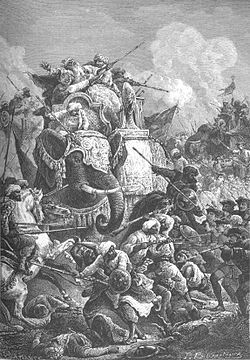- Nawab of the Carnatic
-
 Death of the Nawab Anwaruddin Muhammed Khan in a battle against the French in 1749, by Paul Philipoteaux.
Death of the Nawab Anwaruddin Muhammed Khan in a battle against the French in 1749, by Paul Philipoteaux.
Nawabs of the Carnatic (also referred to as the Nawabs of Arcot) , ruled the Carnatic region of South India between about 1690 and 1801. They initially had their capital at Arcot,vellore city . Their rule is an important period in the history of Tamil Nadu, in which the Mughal Empire gave way to the rising influence of the Maratha Empire, and later the emergence of the British Raj.
Contents
Carnatic
The old province known as the Carnatic, in which Madras (Chennai) was situated, extended from the Krishna river to the Coleroon, and was bounded on the West by Cuddapah, Salem and Dindigul, all of which formed part of the Sultanate of Mysore. The Northern portion was known as the Mughal Carnatic, the Southern the Maratha Carnatic with the Maharatta frontier fortress being Gingee. Carnatic, the name commonly given to the region of Southern India between the Eastern Ghats and the Coromandel Coast and the Western Ghats, extends from Palghat to Bidar and stretches from the Guntur district of Andhra Pradesh in the North, to Cape Comorin at the Southern-most tip of Tamil Nadu State.[citation needed]
History
 Mohamed Ali Khan Wallajah, (1717 - 1795)
Mohamed Ali Khan Wallajah, (1717 - 1795)
The Nawabs of the Carnatic trace their origin back to second Caliph Umar ibn al-Khattab.[1] The Nawabdom of the Carnatic was established by the Mughal Emperor Aurangzeb, who in 1692 appointed Zulfiqar Ali Khan as the first Nawab of the Carnatic, with his seat at Arcot as a reward for his victory over the renegade Marathas led by Rajaram[1]. With the Vijayanagara Empire in serious decline, the Nawabdom of the Carnatic controlled a vast territory south of the Krishna river. The Nawab Saadatullah of (1710-1732) moved his court from Gingee to Arcot. His successor Dost Ali (1732-1740) conquered and annexed Madurai in 1736.
Muhammed Ali Khan Wallajah (1749 - 1795 ) was freed from his suzerainty and made the independent ruler of the Carnatic by the Mughal emperor in 1765. His rule was long and mostly peaceful. He donated generously to Churches, Temples and Mosques. The temple at Sri Rangam was one which benefited from his generosity.
The growing influences of the English and the French and their colonial wars had a huge impact on the Carnatic. Wallajah supported the English against the French and Hyder Ali, placing him heavily in debt. As a result he had to surrender much of his territory to the East India Company.
The thirteenth Nawab, Ghulam Muhammad Ghouse Khan (1825–1855), died without issue and the British annexed the Carnatic Nawabdom applying the doctrine of lapse. Ghouse Khan's uncle Azim Jah was created the first Prince of Arcot (Amir-E-Arcot) in 1867 by Queen Victoria, and was given a tax free pension in perpetuity. This privilege continues to be honoured by the Government of India. This status is protected by the Indian Constitution and the family continues to retain its privileges and titles. The current Prince of Arcot Abdul Ali came to the title in July 1994.
List of rulers
Subedar Nawabs of the Carnatic under the Mughal Empire
Name Reign Began Reign Ended 1 Zulfiqar Khan Nusrat Jung 1690 1703 2 Daud Khan 1703 1710? 3 Muhammad Sa'adatullah Khan I 1710 1732 4 Dost Ali Khan 1732 1740 5 Safdar Ali Khan 1740 1742 6 Muhammad Sa'adatullah Khan II 1942 1944 7 Anwaruddin Muhammed Khan 1744 31 July 1749 Semi-Independent Nawabs of Carnatic
Name Reign Began Reign Ended 1 Anwaruddin Muhammed Khan 1744 31 July 1749 Nawabs of Carnatic under European Influence
Name Reign Began Reign Ended 1 Chanda Shahib 1749 1752 1 Muhammad Ali Khan Wala-Jah 31 July 1749 16 October 1795 3 Ghulam Hussaini Umdat-Ul-Umara 1795 1801 4 Azim-ud-Daula 1801 1819 5 Azam Jah 1819 1825 - Silver Shaded Rows signify the French East India Company.
- Yellow Shaded Rows signify the British East India Company.
Princes of Arcot
Lineage Amir Reign Azim Jah 1867 - 1874 Sir Zahir-ud-Daula Bahadur 1874 - 1879 Intizam-ul-Mulk Muazzaluddaula Bahadur 1879 - 1889 Sir Muhammad Munawar Khan Bahadur 1889 - 1903 Sir Ghulam Muhammad Ali Khan Bahadur 1903 - 1952 Ghulam Mohiuddin Khan Bahadur 1952 - 1969 Ghulam Mohammed Abdul Khader 1969 - 1993 Muhammed Abdul Ali 1993 - current See also
- Carnatic Wars
- Amir Mahal
- Nizam of Hyderabad
- Nawab of Masulipatam
- Nawab of Banganapalle
- History of Tamil Nadu
- List of Sunni Muslim dynasties
References
Categories:- Dynasties of India
- Indian Princely States
- History of medieval India
- Nawabs of India
- History of Tamil Nadu
Wikimedia Foundation. 2010.

